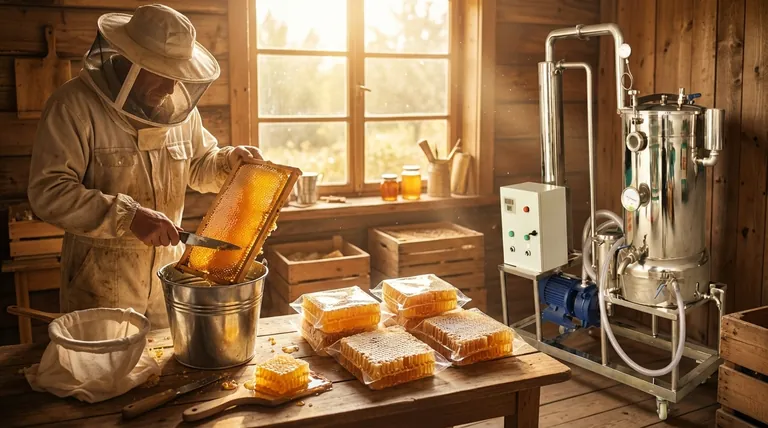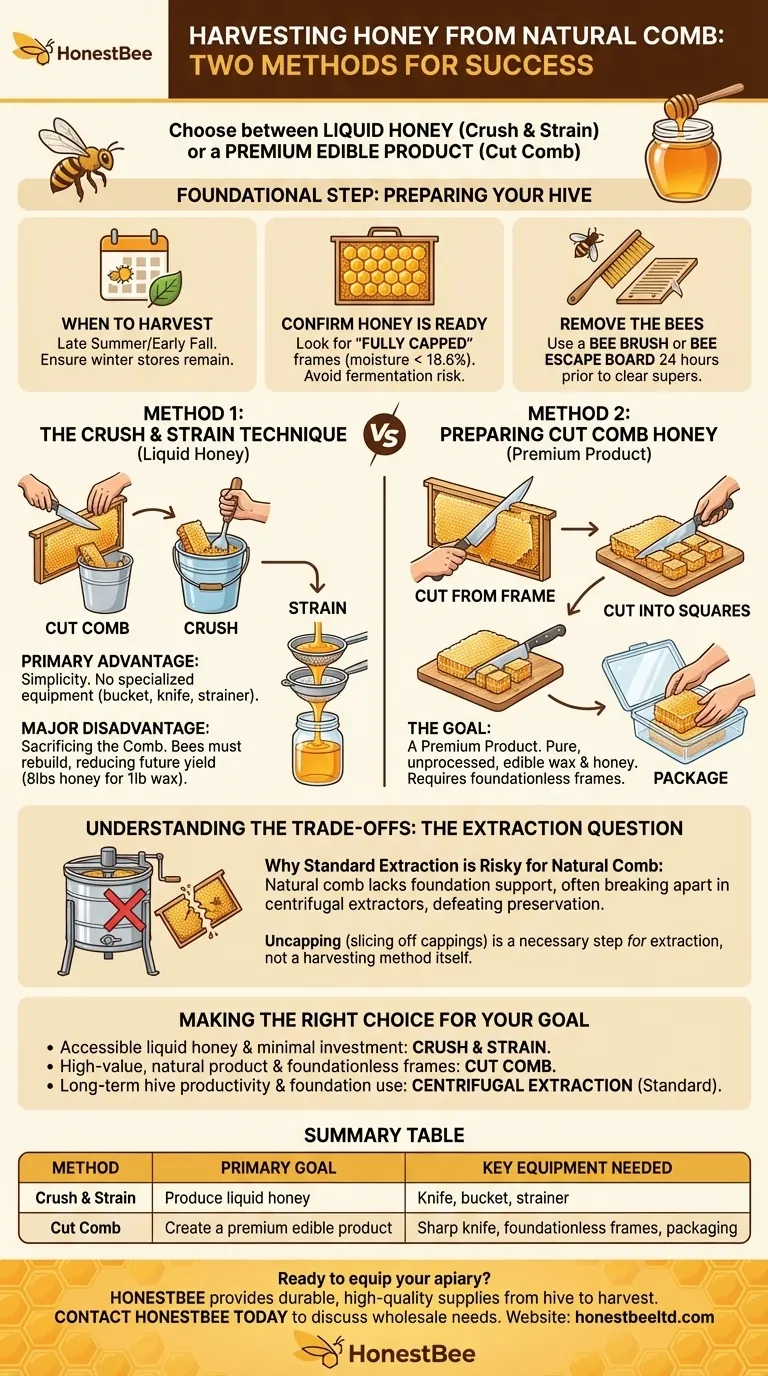To harvest honey from natural comb, you have two primary methods: the "crush and strain" technique to produce liquid honey, or preparing "cut comb" to be consumed wax and all. The crush and strain method is the most common for backyard beekeepers as it involves simply cutting the comb from its frame, crushing it, and filtering the honey through a strainer.
Your choice of harvesting method depends entirely on your end goal. The central decision is whether to sacrifice the comb to get liquid honey (crush and strain) or to preserve the comb as a premium, edible product (cut comb).

Foundational Step: Preparing Your Hive for Harvest
Before you can choose a method, you must properly prepare the frames. This ensures the honey is ready and minimizes stress on the bees.
When to Harvest
The best time to harvest is typically in the late summer or early fall. This timing is dependent on your local climate and nectar flow.
You must ensure you leave enough honey stores for the colony to survive the upcoming winter. A common mistake is taking too much, which can weaken or kill the hive.
Confirming Honey is Ready
Look for frames that are "fully capped." Bees seal each cell with a fresh wax capping only when the honey has been fanned down to the correct moisture content (below 18.6%).
Harvesting uncapped or partially capped honey risks fermentation, as the high moisture content will cause it to spoil.
Removing the Bees from the Comb
You must clear the bees from the honey frames (known as supers) before bringing them indoors.
The simplest way is to use a bee brush to gently sweep the bees off each frame, one by one. Alternatively, a bee escape board can be placed between the honey supers and the main hive body 24 hours before harvest. This one-way door allows bees to move down into the hive but prevents them from returning to the honey frames.
Method 1: The Crush and Strain Technique
This is the most straightforward and low-cost method for extracting liquid honey from natural, foundationless comb.
How It Works
First, use a knife to cut the honeycomb away from the top bar or frame, letting it fall into a food-grade bucket.
Next, use a clean tool (like a large spoon or potato masher) to crush the comb and wax, breaking open all the honey cells.
Finally, pour the mixture of honey and crushed wax through a series of progressively finer strainers or cheesecloth to separate the liquid honey from the wax debris. The resulting wax can be saved for rendering and other projects.
The Primary Advantage: Simplicity
This method requires no specialized or expensive equipment. A bucket, a knife, and a strainer are all you need to get started, making it ideal for new beekeepers or those with only one or two hives.
The Major Disadvantage: Sacrificing the Comb
The bees expend significant energy and resources (consuming about 8 pounds of honey to produce 1 pound of wax) to build their comb. Destroying it means they must start from scratch, which can reduce the next season's potential honey yield.
Method 2: Preparing Cut Comb Honey
Instead of extracting the honey, this method involves packaging the comb itself as a final product.
How It Works
This technique only works with frames that have no internal wires or foundation. You simply use a sharp knife to cut the fully capped comb directly from the frame.
These large pieces are then cut into smaller, marketable squares or rectangles and placed into special clear plastic boxes for sale or storage.
The Goal: A Premium Product
Cut comb is considered a delicacy and can be sold at a premium. It offers a pure, unprocessed honey experience, as the consumer eats the honey and the edible beeswax together. This is less a method of extraction and more a method of preparation.
Understanding the Trade-offs: The Extraction Question
While centrifugal extraction is the standard in commercial beekeeping, it is often unsuitable for purely natural comb.
Why Standard Extraction is Risky
A honey extractor uses centrifugal force to spin honey out of the cells. This process relies on the structural support of a plastic or wired wax foundation within the frame.
Natural comb built without foundation is often too fragile. Placing it in an extractor will likely cause it to break apart, creating a significant mess and defeating the purpose of preserving the comb.
The Role of Uncapping
Before any frame can be extracted, the wax cappings must be sliced off with a heated knife or uncapping fork. Uncapping is a necessary step for extraction; it is not a harvesting method on its own.
Making the Right Choice for Your Goal
Your harvesting strategy should align directly with your equipment, your beekeeping philosophy, and what you want to do with the final product.
- If your primary focus is accessible liquid honey with minimal investment: The Crush and Strain method is your most direct and effective path.
- If your primary focus is producing a high-value, natural product for sale or as a gift: Preparing Cut Comb is the ideal choice, provided your frames are foundationless.
- If your primary focus is long-term hive productivity and you use foundation: Centrifugal extraction is the industry standard because it preserves the drawn-out comb for the bees to reuse.
By understanding these distinct methods, you can choose the one that best suits your hive and your goals.
Summary Table:
| Method | Primary Goal | Key Equipment Needed |
|---|---|---|
| Crush & Strain | Produce liquid honey | Knife, bucket, strainer |
| Cut Comb | Create a premium edible product | Sharp knife, foundationless frames, packaging |
Ready to equip your apiary for a successful harvest?
Whether you're a commercial beekeeper maximizing yield or a distributor supplying the tools for success, HONESTBEE provides the durable, high-quality beekeeping supplies and equipment you need. From uncapping knives to storage buckets, we support your operation from hive to harvest.
Contact HONESTBEE today to discuss your wholesale needs and ensure your beekeeping business is built on a strong foundation.
Visual Guide

Related Products
- Honey Concentrating Vacuum Heating Thickening Machine Dehumidifier for Honey
- Professional Thermostatic Conical Honey Melter
- Plastic Hand Crank 2 Frame Honey Extractor Low Price
- 8-Frame Electric Self-Reversing Honey Extractor Spinner for Commercial Honey Extraction Equipment
- Professional Extra-Wide Uncapping Fork with Bent Tines for Beekeeping
People Also Ask
- What is the effect of excess moisture on honey's nutrients? Preserve Quality and Prevent Spoilage
- What is required for the cooling system when using circulating water in the honey vacuum thickener? Essential Components for Efficient Processing
- Why is 304 stainless steel used in honey processing? Protect Your Honey's Purity & Flavor
- What additional functions does a honey vacuum thickener have? Achieve a Stable, Commercial-Grade Product
- What are the main components of the honey vacuum thickener equipment? A Guide to Preserving Honey Quality



















